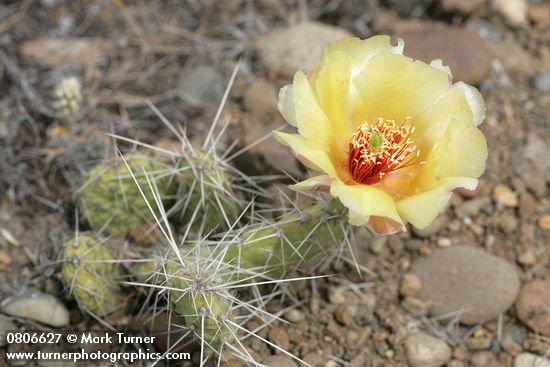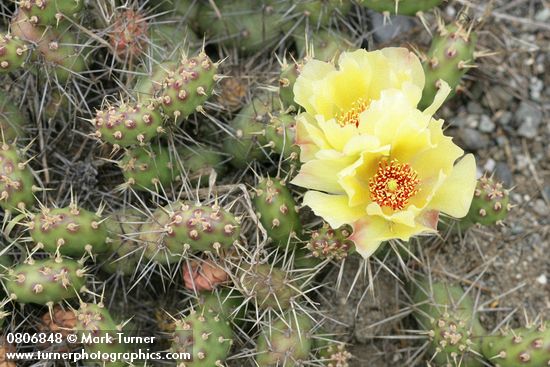Prickly Pears
One of the plants on my list to find and photograph has been Opuntia fragilis, fragile prickly pear cactus, which grows on both sides of the Cascades in Washington and other places in the Northwest. I’d seen it, or at least thought I had, in a couple of places but never found it in bloom until this month.

I say I thought I’d seen fragile prickly pear because that’s how a bunch of it in Yakima Canyon keyed out in Flora of the Pacific Northwest. The photograph above is from the Umtanum Recreation Site about halfway between Ellensburg and Yakima where the cactus grows next to the campground. However, I’ve since learned that these plants are actually Opuntia columbiana, grizzleybear prickly pear. The pads are flatter than O. fragilis and some authors say it’s a hybrid species. Others write it as Opuntia x columbiana, indicating that it’s a proposed species. Still others call it O. erinacea var. columbiana. No wonder I was confused. I found a web Primer on Washington Native Cacti that helps to sort them out. See more photos of the Yakima Canyon cactus on my Kittitas County June 19 page on the Pacific Northwest Wildflowers website.
Since my photos from Yakima Canyon weren’t what I thought they were, I headed out again yesterday afternoon in search of the real thing. I went to Ebey’s Landing National Historical Reserve near Coupeville on Whidbey Island armed with GPS coordinates interpolated from WTU Herbarium botanical foray records from 2004. The species is somewhat rare, classified in Washington as a species of concern, so exact locations aren’t published. I had looked for O. fragilis at Ebey last month and didn’t find it, but this time I located it where I’d seen it several years ago just above the logs at the back of the beach. The specimen didn’t look very healthy and wasn’t in bloom. Since the steep sandy slope is somewhat eroding, although held in place by grasses and other plants, I thought there must be more plants straight up the hill.

I left my pack and tripod on the beach and headed up, keeping a sharp lookout for cactus, especially for the showy yellow flowers. This photo is from the first clump I found, about 50 feet above the beach. Notice how fat and rounded the pads are. O. fragilis doesn’t form very large clumps and they aren’t very tall, so the browning grasses on the hillside kept the cactus mounds rather well hidden. As I looked up the hill I spotted several more cacti in bloom. At that point I returned to the beach for my camera pack and tripod and went to work.
When I find a plant of interest I try to photograph it from several angles, showing foliage (or pads in the case of cacti), flowers, details, and a habitat view. I used three different lenses on this plant — a 90 tilt-shift, 24-105 for wide views, and a 100 macro. An overcast sky made nice soft light, but the habitat view wasn’t as interesting as if the sky were clear and the water reflecting blue. See the whole set on my Ebey’s Landing page.
I also found other plants I associate more with the dry east side of the mountains, including tapertip onion (Allium acunimatum) and harvest brodiaea (Brodiaea coronaria). It seems counterintuitive to have a desert just above the beach, but Ebey’s Landing is in the Olympic rain shadow. Weather data for Coupeville shows about 20 inches of rainfall annually and the soils on the bluff at Ebey are sandy and well-drained.

